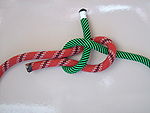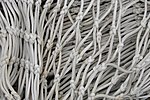Schotstek
| Schotstek | |
|---|---|

|
|
| Type | connection |
| application | Connection of two ropes of equal or unequal thickness |
| Ashley No. | 1, 1431, 1433 |
| strength | approx. 50 % |
| Synonyms | Pod stitch, back stitch, weaver's cross knot, weaver knot |
| English | Sheet bend |
| List of nodes | |
The Schotstek is a knot for connecting two ropes .
Names and history
Seafarers used to use this knot to tie the sheet together. This is where the name comes from.
Firefighters call him pods Stich , the THW he is undercut and scouts he is the Weber square knot or crossed reef knot .
properties
The Schotstek roughly halves the load-bearing capacity of the rope. It can be put on slip and is then detachable even under heavy loads. If there is little to no load, this knot with or without slip is at risk of loosening. It should therefore only be used for connections on a permanent basis.
Knot
A bay is placed in the thick end . With the thin end you drive into the bay, around it (first around the loose, then around the standing part) and put it through between the thin end and the bay. In the end, both ends are on the same side. If the lines are of different strength, it must be ensured that the thick rope forms the bay.
In its form of Schotstek corresponds Palstek with inner end. The only difference is that the fixed part of the thick line is not connected to a loop with the loose part of the thin line.
The Schotstek gets its stability from the fact that the standing part of one rope pinches the loose part of the other rope. That is why the less reliable left-handed Schotstek (Ashley No. 1432) should be avoided if the ropes are of different types. With the right-handed Schotstek, the loose ends point to the same side, with the left-handed, however, in different directions. As a result, the standing ends lie against each other so that they cancel each other's pulling effect. Thus, the force to pinch the loose ends is reduced.
use

The Schotstek is suitable for connecting two ropes, both for ropes of the same strength and for ropes of different strengths or different stiffnesses.
In addition, the Schotstek is used together with the weaving line to tie nets such as fishing nets and hammocks . Here it is called a weaver's knot because it is tied using a different method and different material.
Anglers used the Schotstek as a jam knot to connect a loop on the flying line to the leader .
Alternatives
- The double schotstek is suitable for ropes of very different thicknesses or of different types.
- A figure-of-eight is more reliable when the load changes . But it is more difficult to solve and more complex to knot.
- A thin line ( Zeising ) is connected to the Zeisingstek with a thick rope.
- For joining thick hawsers is Carrick Bend most suitable.
- The spar stitch is suitable for joining wet, slippery lines such as fishing line .
- The double spar stitch is a particularly secure connection .
Modifications

- With an additional turn, the double schotstek is created .
- To give the Schotstek a slimmer shape, the protruding end is tucked back again. Thus he can be z. B. easier to pull through eyelets and looks "tidy".
Web links
Individual evidence
- ^ The Ashley book of knots, p. 19, 6th edition - Hamburg: Edition Maritim, 1999
- ^ A b Clifford W. Ashley: The Ashley Book of Knots . ISBN 3-89225-527-X .
- ↑ Federal Office for Civil Protection and Disaster Aid (ed.): Fire Brigade Service Regulation 1 . S. 113 ( bund.de [accessed on July 13, 2018]).
- ↑ gutefrage.net GmbH: Making fishing nets - instructions
- ^ The Ashley book of knots, p. 19, 6th edition - Hamburg: Edition Maritim, 1999
- ↑ Jam knot






